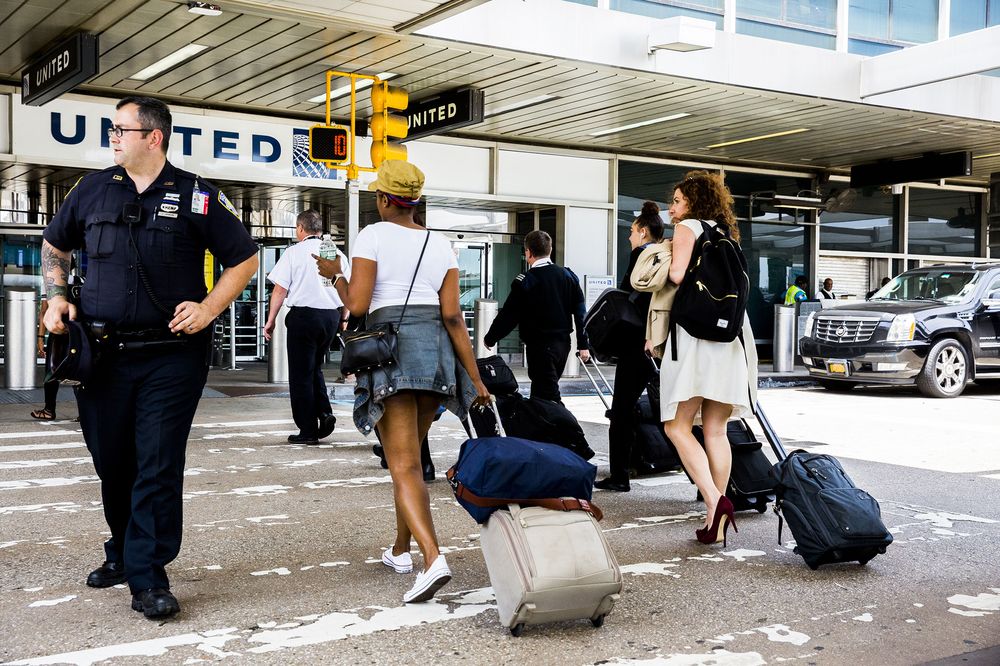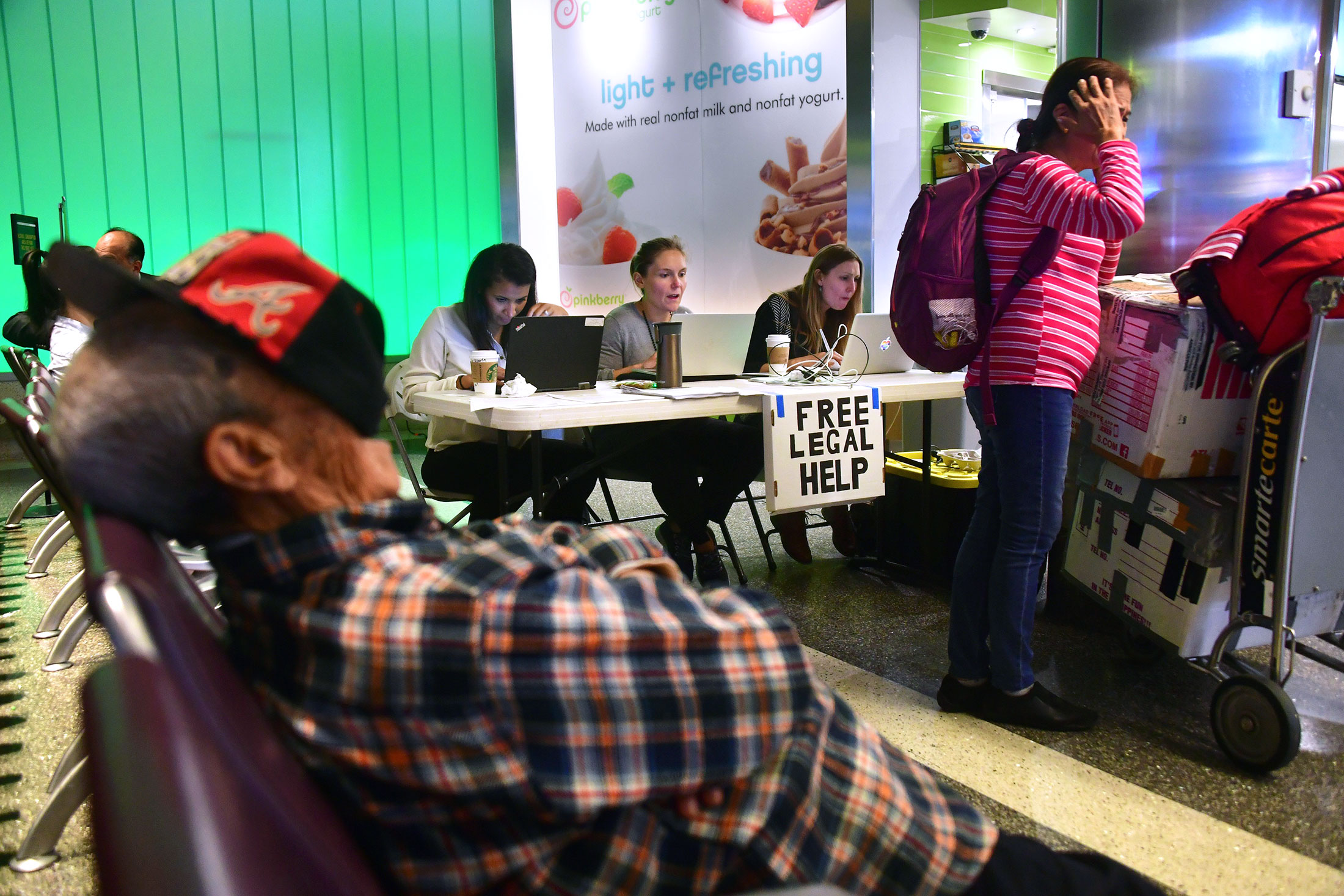
Travelers pull luggage while arriving at LaGuardia Airport (LGA) in New York, U.S., on June 29. Photographer: David Williams/Bloomberg
President Donald Trump says his travel restrictions are aimed at keeping the U.S. safe from radical Islamic terrorism, while critics accuse him of imposing a Muslim ban. Whatever the short-term executive order accomplishes, following multiple revisions and months of court challenges, its impact on immigration policy and practices will be felt for years to come. Some winners and losers in this new regime are obvious, but there may also be some surprises.
More Refugees
The refugee ban will actually add more refugees.
Trump used his power to reduce refugee entries for the current fiscal year to 50,000 from the target of 110,000 set by President Barack Obama. But the number of refugees who enter the U.S. is likely to end up higher. Under the Supreme Court’s June 26 ruling, refugees who have “bona fide” ties to the country may be admitted, and they don’t count as part of the cap.
Immigration advocates say that more than half of all refugees admitted each year have such ties. So even though the U.S is just days away from hitting the 50,000 figure, many more refugees may be entering the country while the 120-day ban is in effect.
“In all likelihood, I would expect we would end up with more than 50,000 this year,” said Eric Schwartz, president of Refugees International and former assistant secretary of state for population, refugees and migration. “Once we get to 50,000 there will inevitably be some number of refugees that meet the ‘bona-fide’ test and if the administration monkeys around with that by trying to slow down approvals, then they’ll be in violation of the court decision.”
Christian Disadvantage
The president originally sought to help Christians facing persecution, but the ban now in place may keep out more Christians than Muslims.
In the first travel order in January, before court challenges prompted Trump to issue what he called a “watered down” directive in March, the worldwide refugee ban included an exemption for “religious minorities.” Trump asserted in an interview with Christian Broadcasting Network days after signing the order that it was “impossible, or at least tough,” for Syrian Christians to enter the U.S., while Muslims had easier access.
Now that the ban omits religious preferences, refugees who identify as Christian will be competing with Muslims and those of other faiths for precious few openings in the U.S. Of the 23,577 refugees from across the world taken into the U.S during the first half of 2017, 48 percent were Christian and 41 percent were Muslim, according to State Department statistics. Christians, like everyone else, will have to prove they have strong family ties in America to qualify for sanctuary — and that will now be harder because they can’t count on refugee resettlement agencies to sponsor them.
“There’s a lot of frustration because there’s still not full clarity and this entire directive isn’t necessary,” said Linda Hartke, President of Lutheran Immigration and Refugee Service based in Baltimore.

Volunteer lawyers sit at a table in Los Angeles International Airport on June 30.
Photographer: Frederic J. Brown/AFP via Getty Images
Families Torn
The Supreme Court put an emphasis on close family ties in requiring exemptions from the ban, but the result may be more families torn apart.
Under the Supreme Court’s order, the 90-day ban on entry for citizens of six mostly Muslim nations was narrowed to exclude parents and other close relations, but most of them still won’t get in, according to attorney Reaz Jafri, who leads the immigration practice at Withers Bergman LLP in New York.
Using Iran as an example, the U.S. has long denied visas to the closest family members of Iranian-Americans who are trying to visit from Iran; immigration officials fear they’ll seek green cards once they get here, according to Jafri. Only more-distant relatives like aunts and uncles have been allowed in large numbers, and that group is now blocked under the rules set in place this week.
The Supreme Court “may not have thought through how this ties in with existing immigration law, which the decision does not change,” Jafri said. “Anyone that thinks the court’s decision was a victory for citizens from the six countries will be disappointed.”
‘Deep State’
The president who keeps invoking his executive authority to protect the nation won’t have the last word on who gets in.
The latest version of the ban gives broad discretion on granting visas to career diplomats — the very people who make up the ranks of the “Deep State” that the White House and Trump’s Cabinet suspects is working against them. They may disregard the ban if they suspect an applicant would suffer “undue hardship” otherwise. For people living in Somalia, Syria or the other four countries covered by the ban, diplomats could argue that simply staying home in some of these war-ravaged, famine-stricken death zones is a hardship.
“Consular officers have considerable discretion,” said Doris Meissner, director of the U.S. Immigration program at the Migration Policy Institute. “As compared with almost anything in our decision-making process, consular officers’ judgments are final and not renewable and that’s pretty unique.”
Broader Reach
Thousands of refugees who aren’t from countries suspected of fostering terrorism will be blocked from entering the U.S.
If current trends continue, the temporary ban on refugees worldwide may bar entry from more people from the Democratic Republic of Congo, Myanmar and Ukraine combined than from the six nations targeted by Trump.
Between the three nations, which are enduring military conflicts, civil war and genocide, the U.S. has taken in 7,978 refugees in the first half of this year, compared with 6,883 from the six countries Trump has identified as national security threats to the U.S., according to State Department statistics.
In Congo, reports of militia slashing toddlers and pregnant women continue to make headlines; Myanmar is refusing outside investigations into the mass-murder of its Rohingya population and Ukrainians are still on the run, fleeing Russian separatists. But unless they can provide proof of a “bona fide” relationship with a U.S. citizen, people from these countries seeking sanctuary in America will be turned down.

